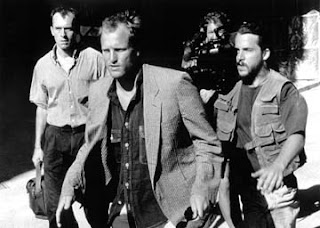In the siege of Sarajevo, the literature and film focused on how those trapped within the city survived whether it was Sarajevan citizens or foreign journalists. The psychological warfare was horrendous. This seems to be a major part of modern warfare, and so much crueler and inhumane than wars where armies charged in and killed indiscriminately. In this siege, snipers held people’s lives at bay continually. One never knew when the sniper might strike, but they knew they were there and could randomly choose who and when they wanted to kill. Snipers humiliated the people as they watched them decide on how to cross a street, walking straight, running zigzagged, alone or helping someone. Eyes were always on them, making them live in fear as they scrounged for food and water, knowing at any moment they could be shot. Yet there was also the indiscriminate shelling that showed no mercy to citizens and the institutions that were supposed to be protected during “legal” sieges.
The Cellist of Sarajevo was framed from the point of view of 3 citizens going through their daily routines and becoming further distressed by the long range effects of the siege. It also revealed the daily routine of the cellist who for the 22 days played the cello in memory of those killed while standing in a bread line in front of his apartment. The song he plays was once destroyed, but later reconstructed. It may not be the original but it is still beautiful and this is the hope the cellist also wants to offer to the living in the city of Sarajevo- that their city may be rebuilt beautifully, albeit changed. The three citizen’s lives interconnected in small ways to the cellist, but in the end the music and demeanor of the cellist touched them greatly and led them to maintain their identity and hold onto their humanity.
Kenan, the family man wanted to give up on everything, even Ms.Ristovski, after the struggle to fetch water nearly escaping death and witnessing the deaths of those around him and the greed of his own people taking advantage of his friend. But the cellist’s music had given his weary mind and body rest from the reality of the war. With a renewed spirit, he went back out of his way to get his neighbors water, joked with his wife and was overjoyed with hope over a little electricity and simple pleasures for his family. And he continued to fetch water and care for his family.
Dragan had been overwhelmed by fear in the war and couldn’t even move to help a friend after a haggard day deciding when to cross the street. But in the end he comes to the realization that he lost his grip on life in defending himself from death (224). Now he must live and flourish. He stands up for his city he loves and doesn’t let a camera man film the dead hatless man. He will preserve the city he remembers for the world. He now addresses others joyfully instead of downcast. He goes out of his way to help those in need. He will live his life with zeal instead of fear (224).
Arrow (her code name) was a defender for the city. She was put in charge of protecting the cellist from a sniper. She killed the sniper, but momentarily hesitant as she saw his eyes were shut and his demeanor relaxed listening to the cellist. But it was her orders and had to be done. Later her own defenders called upon her to kill a seemingly innocent old man and she refused to do it and left. After 10 days she returned to her apartment. The night before she had listened to the cellist play for the last time. He put his bow down among the flowers and she laid her rifle down. She would no longer protect a city, whose own defenders acted like the ruthless men on the hill. She heard the steps of the defenders coming, she knew they were coming to get her for her defiance, but she did not pick up her hand gun to kill them. She was no longer Arrow, but Alisa.
I gathered that the world saw the siege as Dragan’s stray dog. The world saw images of what was happening, yet just kept going on with their own lives “uninterested.” Mankind had things to do and places to go and it didn’t have time to bother with non-essentials. And the citizens of Sarajevo sensed the inhumanity, as they saw humanity drift out of sight.
Welcome to Sarajevo was framed from the reporters’ point of view from within the city. They were moved by the suffering and the murders. Yet internal conflict erupts about how much they can and should do. When one reporter assisted someone after a shooting he was condemned by most of the other reporters. Yet they worked together to get the children out of the city. They were astonished after their continued reporting and the world would not help; and royal divorces were more newsworthy than man’s inhumanity to man. Disconcerting too were the many excuses from all the bureaucrats: Plenty others are in the same condition or worse; It can’t be that bad; It has to go through bureaucratic process. Don’t count on the West; Don’t Dream. Some acted concerned; but ultimately did nothing. The reporters also saw the corruption from within, as did the citizens in the Cellist, when lured into an apartment and then robbed and shot at. In the end though we see the people of the city and the reporters transcend all the iniquities through the music of the cellist. The world may be slow to help, but they have to have something on which to hold. Music takes them away from this disturbing world and helps them to find that spark inside themselves that makes life worth living.












